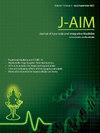频繁服用Guggulu Tiktakam Kwatha后急性尿潴留及其处理- 1例报告
IF 1.9
Q3 INTEGRATIVE & COMPLEMENTARY MEDICINE
引用次数: 0
摘要
患者男性,72岁,确诊为感染性脊柱炎,因右髋关节及下背部(腰骶区)剧烈疼痛,非门诊住院。考虑到病情的严重性,我们按照Muhurmuhu(频繁管理)的时间表来管理Kwatha。最初的药物减轻了疼痛,但没有升高的c反应蛋白(CRP)。为了降低升高的CRP,我们给药Amruthotharam Kwatha和Guggulu Tiktakam Kwatha (GTK),剂量为每2小时30毫升,共8次。CRP开始减少,但我们遇到了急性尿潴留作为药物不良反应。Naranjo药物不良反应概率量表记录得分为8分,表明AE可能是由于服用Muhurmuhu时间表中的Guggulu Tiktakam Kwatha (GTK)引起的。当患者超过6小时没有排尿时,我们对左侧motthira Kala Marma进行了Marma治疗。病人在玛玛治疗后半小时内排尿。临床上,用药后疼痛明显减轻,CRP恢复正常,患者进入门诊模式。这一病例报告表明,像GTK这样的药物应谨慎使用,因为它可能使情况复杂化。本病例报告还强调了一个事实,即Marma疗法可能是解决急性疾病的一种可能模式。本文章由计算机程序翻译,如有差异,请以英文原文为准。
Acute urinary retention following frequent administration of Guggulu Tiktakam Kwatha and its management - a case report
A 72-year-old male patient, a diagnosed case of infective spondylodiscitis, was admitted in our hospital for severe pain in the right hip and lower back (in the lumbo-sacral region) in a non-ambulatory mode. Considering the criticality, we administered Kwatha in a Muhurmuhu (frequent administration) schedule. The initial medicines reduced pain, but not the elevated C-reactive protein (CRP). To reduce this elevated CRP, we administered Amruthotharam Kwatha and Guggulu Tiktakam Kwatha (GTK) in the dosage of 30 ml every 2 h for eight times. CRP started reducing, but we encountered an acute urinary retention as an adverse drug reaction. Naranjo Adverse Drug Reaction Probability Scale recording gave a score of eight, which shows that the AE could be probably due to administration of Guggulu Tiktakam Kwatha (GTK) in Muhurmuhu schedule. When the patient did not void urine for more than 6 hours, we did Marma therapy on left Mootthira Kala Marma. The patient voided urine within half an hour of Marma therapy. Clinically, after the medications, pain reduced considerably, CRP came to normal, and the patient came to an ambulatory mode. This case report shows that medicines like GTK should cautiously be administered, as it may complicate. This case report also focusses light on the fact that Marma therapy could be a possible mode of tackling acute conditions.
求助全文
通过发布文献求助,成功后即可免费获取论文全文。
去求助
来源期刊

Journal of Ayurveda and Integrative Medicine
INTEGRATIVE & COMPLEMENTARY MEDICINE-
CiteScore
4.70
自引率
12.50%
发文量
136
审稿时长
30 weeks
 求助内容:
求助内容: 应助结果提醒方式:
应助结果提醒方式:


